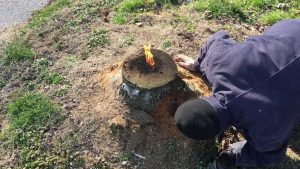How to Remove a Stump Jumper?
Stump jumpers, while sometimes neglected, can pose severe challenges in landscaping and property management. Understanding the subtleties of their removal is critical for maintaining a clean and safe atmosphere. In this site-specific Arbortrueca guide, we’ll go over how to remove a stump jumper. From the anatomy of stump jumpers to the various removal strategies, we provide readers with in-depth insights and expert advice. By learning about the complexities of stump jumper removal, homeowners may manage their landscaping projects with confidence and proficiency. Join us as we delve into the topic of stump jumper removal, allowing you to transform your environment into a thriving and visually appealing outdoor space.
Anatomy of Stump Jumpers
Several components help stump jumpers, also known as root balls or stump bases, stay firmly in the ground. The root system is at the heart of a stump jumper, which reaches deep into the soil and serves as the foundation for the tree’s stability. Layers of earth, detritus, and organic materials develop around the roots over time, strengthening the stump jumper’s hold in the ground. Furthermore, depending on the tree species and age, stump jumpers may contain portions of the trunk or bark, which adds to their overall structure. Understanding the anatomy of stump jumpers is critical for developing successful removal tactics based on their specific composition and characteristics.

Characteristics of stump jumpers
Stump jumpers have various specific traits that set them apart from other tree remnants. These include their strong root systems, which hold them firmly in the ground and make removal difficult. Stump jumpers often show varied degrees of deterioration, depending on the tree type, age, and climatic conditions. Furthermore, their size and shape vary greatly, ranging from small, compact stumps to vast, sprawling root balls. Understanding these qualities is critical for developing effective removal procedures and guaranteeing successful stump jumper removal operations.
Types of Stump Jumpers
There are several categories for stump jumpers, each with unique eradication obstacles. One typical form is the single-trunk stump jumper, which has a single primary trunk and root system. Another form is the multiple-trunk stump jumper, which has several tangled trunks and roots. Moreover, root crown stump jumpers emerge when the destruction of the tree’s crown or upper portion leaves the root system intact. Understanding the many varieties of stump jumpers is critical for determining the most effective removal approach and equipment to address each type’s unique characteristics.
Importance of Stump Jumper Removal
Removing stump jumpers is critical for both property owners and landscapers. Stump jumpers can be dangerous, particularly in high-traffic areas, where they can cause tripping and injury. Furthermore, decaying stump jumpers can attract pests and insects, jeopardizing the health of surrounding vegetation. Additionally, keeping stump jumpers in place might impede landscaping efforts, making it difficult to plant new plants or erect structures.

Furthermore, stump jumpers can limit the growth of nearby plants by competing for nutrients and water. Property owners can improve the appearance of their landscape by removing stump jumpers, resulting in a cleaner and more appealing outdoor space. Furthermore, stump jumper removal improves soil health and prevents regrowth, ensuring long-term landscape upkeep. Overall, prioritizing stump jumper removal is critical for increasing safety, maintaining landscape aesthetics, and encouraging healthy vegetation development.
Tools and equipment
- Chainsaw
- Stump grinder
- Excavators
Techniques for stump jumper removal
Various approaches, tailored to the unique properties of the stump and surrounding environment, are necessary to remove stump jumpers. Here are some often-used methods:
Chemical Removal: Chemical stump removers can hasten the decomposition process, making the stump softer and easier to remove. This process entails drilling holes in the stump and applying a chemical solution, which breaks down the wood over time.
Mechanical Extraction: Mechanical procedures, such as winches or excavators, include dragging or excavating the stump and its roots from the ground. This method is effective for large or resistant stump jumpers.
Stump grinding and mulching: We use specialized equipment to grind the stump and roots into small wood chips. You can then use these chips as mulch or dispose of them appropriately.
Each procedure has pros and cons, factors like size, location, and intended outcome determine the method. Consulting with a competent arborist can help you choose the best way to remove stump jumpers.
How to remove a stump jumper?
Expert Tips to Remove Stump Jumper
To remove stump jumpers successfully, meticulous planning and execution are required. Here are some expert methods that can improve the effectiveness of the removal process:
Assess Site Conditions: Before beginning removal, properly inspect the site, including soil type, surrounding vegetation, and accessibility. This information will assist in determining the most appropriate removal strategy and equipment.
Choose the Right Removal Method: When deciding on a removal procedure, consider the stump jumper’s size, position, and complexity Chemical, mechanical, or grinding procedures can also be acceptable.
Ensure Safety Measures: During the removal process, prioritize safety by wearing proper protective gear and following safety guidelines. To avoid mishaps, avoid working alone, and keep a safe distance from witnesses.
Proper Stump Debris Disposal: Dispose of stump debris ethically by reusing wood chips as mulch or making arrangements for disposal. Avoid scattering waste around the site, since it might cause tripping hazards and delay landscaping work.
Following these expert guidelines can help property owners speed up the stump jumper removal procedure and achieve successful results while maintaining safety and environmental responsibility.
How long does it take to remove a stump jumper?
The time it takes to remove a stump jumper depends on various factors, including the stump’s size and complexity, the removal method used, and the equipment employed. For smaller stump jumpers, chemical cleanup methods can take several weeks or months to completely dissolve the stump. Mechanical extraction methods, such as utilizing an excavator or a winch, may often remove stump jumpers in a few hours to a day, depending on the stump’s size and location. Typically, stump grinding and mulching operations are faster, taking only a few hours to complete and leaving behind wood chips suitable for mulching or proper disposal. Overall, the duration of stump jumper removal varies from case to case; thus, these aspects must be considered while planning the removal process.
Related Posts:
How to remove the stump jumper chemically?
Chemical removal is a popular approach for getting rid of stump jumpers, especially for smaller stumps or in regions where mechanical equipment may be ineffective. Potassium nitrate is used as a powerful oxidizing agent, accelerating the decomposition process.
We bore holes in the stump, usually around the perimeter and in the center, to start the chemical removal process. We then apply potassium nitrate, sometimes in granular form, to the holes, soaking the stump. Often, we use water to facilitate the chemical’s absorption into the wood.
The amount of potassium nitrate required varies according to the size and density of the stump. As a general rule, apply one pound of potassium nitrate per inch of stump diameter.
Over time, potassium nitrate degrades the wood’s cellulose and lignin, weakening the stump and aiding disintegration. While chemical treatment may take many weeks to months to completely dissolve the stump, it is a hands-off method of stump removal that requires little labor or equipment.
FAQS
Is chemical removal safe for the environment?
When utilized correctly, chemical cleaning processes are generally environmentally safe. To reduce environmental impact, follow manufacturer directions and dispose of chemicals appropriately.
Can I rent stump-removal equipment?
Numerous equipment rental firms provide stump grinders, chainsaws, and other gear for stump removal. Renting equipment might be an affordable choice for DIY enthusiasts.
What are the costs of stump jumper removal?
The cost of stump jumper removal varies depending on the size, location, and removal method. To ensure proper pricing, request quotes from expert arborists or rental firms.
Does stump grinding pose any risks?
While professional stump grinding is typically safe, there is a risk of damage from flying debris and equipment failure. Always use safety precautions.
After removal, can stump jumpers regenerate?
In most circumstances, properly removed stump jumpers will not regenerate. However, residual roots or seeds left in the earth may cause regrowth, necessitating more eradication attempts.
Conclusion
How to remove stump jumpers is important for landscaping and property management. Understanding the anatomy, features, and removal strategies of stump jumpers enables property owners to successfully manage these issues while improving the beauty and functionality of their outdoor spaces. Whether using chemical, mechanical, or grinding processes, safety, environmental responsibility, and proper disposal practices are critical. With the information presented in this adapted tutorial for Site Arbortrueca, readers can execute stump jumper removal initiatives with confidence and expertise, ensuring long-term health and beauty.




